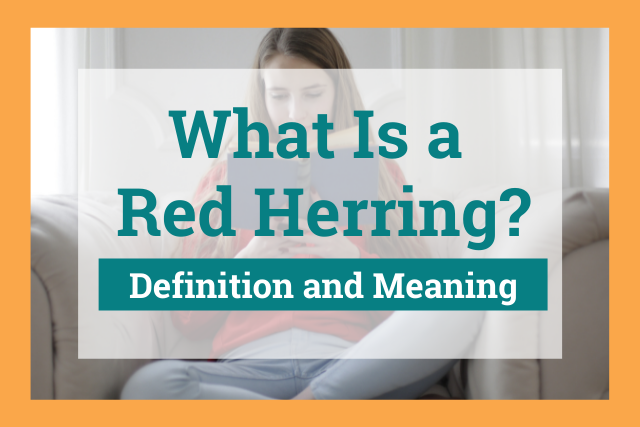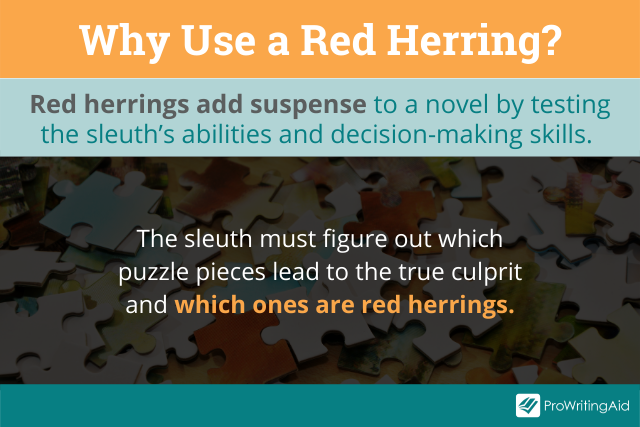
Red herrings are a standard trope in mystery novels. They stop the reader from discovering the true villain, and their intentions, too quickly.
So what exactly is a red herring, and what purpose does it serve?
The term red herring refers to a false clue that distracts the reader from what really matters.
This article will explain what a red herring is in detail, and give you red herring examples from famous crime and mystery stories.
Red Herring Definition
According to the Merriam Webster Dictionary, a red herring is defined as “something that distracts attention from the real issue.”
In other words, red herrings draw the reader’s attention away from what’s really important, like a false clue that leads a detective away from the true culprit.

The etymology of this term is unclear, but some say the term dates back to an 1807 news story by journalist William Cobbett.
Cobbett claimed that he could train hunting dogs by using red herrings—bony fish that were salted and smoked until they turned reddish-brown—to lay a false trail and distract dogs from the scents of the targets they were supposed to be chasing.
Thus, the term red herring now refers to anything that distracts a reader from the true target.
What Does Red Herring Mean in Writing?
In detective stories, a red herring is a misleading clue that directs the sleuth away from the true villain.
The red herring also distracts the reader from figuring out the real culprit and may lead them to draw a false conclusion about someone innocent instead.
Here are some examples of red herrings that you might see in mystery stories:
- An innocent character had a strong motive to kill the victim, such as jealousy, blackmail, or an unpaid debt.
- An innocent character had the means to commit the murder—perhaps they were nearby, have no alibi, or were scheduled to meet the victim around the time of death.
- A false clue appears to incriminate a suspect. For example, an earring next to the body matches a suspect’s earrings, but it later turns out to be a common earring worn by several people.
In logic, a red herring is a fallacy of distraction: bringing up another point to redirect the argument.
It’s a way to divert attention from what really matters, and it’s considered to be a logical fallacy because it's ultimately irrelevant to the main issue at hand.

Red Herring Examples
The best way to understand what red herrings are is to see them in action. Let’s look at some red herring examples in classic mystery novels.
If you haven’t read these books, watch out—there are spoilers ahead!
Red Herring Example in And Then There Were None by Agatha Christie
Agatha Christie’s famous novel And Then There Were None (1939) follows ten people who are invited by an unknown host to stay at a remote island.
When they get to the island, they find a copy of the poem “Ten Little Indians,” which describes ten gruesome deaths. One by one, the ten guests begin to die in ways that match the deaths described in the poem.
The seventh couplet in the poem reads: “Four little Indian boys going out to sea; a red herring swallowed one and then there were three.”
At that point in the story, one of the four remaining guests goes missing. The other three guests conclude that the missing one must be the killer.
Later, they find his dead body on the beach and realize that he was just another victim. His disappearance was a red herring, just like the “red herring” mentioned in the poem, because it distracted them from finding the real culprit.
Red Herring Examples in The Hound of the Baskervilles by Sir Arthur Conan Doyle
The Hound of the Baskervilles is a classic detective novel in which Sherlock Holmes tries to figure out who’s killing the heirs of the Baskerville family.
The main red herring in this story relates to the titular Hound of the Baskervilles. Many people think the family is cursed by a giant spectral dog, who has been killing the heirs out of vengeance.
However, the killer is actually a human, so the myth about the hound only serves to throw everyone off the scent.
Another red herring points to the butler. At one point, Holmes suspects the butler at Baskerville Hall because Sir Henry Baskerville is being stalked in London by a bearded man in a cab, and the butler also has a beard.
However, this false clue is simply a red herring, and the butler turns out to be entirely innocent.
Red Herring Examples in Harry Potter and the Prisoner of Azkaban by J.K. Rowling
In Harry Potter and the Prisoner of Azkaban, Harry is told that Sirius Black is a dangerous murderer who betrayed Harry’s parents and now wants to kill Harry.
When Sirius Black breaks into Hogwarts, everyone assumes that his motive was to try to kill Harry, which is a perfectly plausible explanation.
The truth, though, is that Sirius Black is trying to protect Harry from the person who betrayed the Potters.
Everything he did was to try to protect Harry from Peter Pettigrew, and the lie about him wanting to kill Harry was a red herring to distract everyone from looking for the actual killer.
Examples of Red Herring Fallacy in Politics
One classic example of a political red herring occurred in a 2012 U.S. Presidential debate between Mitt Romney and Barack Obama.
When someone asked the two candidates what policies they would implement to limit the availability of assault weapons, neither candidate truly answered the question.
Instead, Romney and Obama both diverted attention away from the topic of assault weapons.
Obama spoke about catching violence before it gets out of control, and Romney spoke about the importance of raising children in two-parent homes.
Both answers are red herrings since they distracted viewers from the original issue.
Why Do Authors Use Red Herrings?
A mystery novel would be boring—and very short—if the sleuth discovered the real culprit right away.
That’s why authors prefer to provide readers with a mix of different clues, some of which lead to the true culprit and some of which lead to dead ends.
Red herrings are a useful literary device because they divert attention away from the correct suspect, making the book longer and less straightforward.
Red herrings also add suspense in a novel by testing the sleuth’s abilities and decision-making skills.
A mystery is a puzzle, and the sleuth must figure out which puzzle pieces lead to the true culprit and which ones are red herrings. Readers enjoy rooting for the hero as they overcome these obstacles.

Authors often use red herrings as a device in the early sections of their novels to build tension.
Throughout the first half of a mystery novel, the sleuth is in discovery mode. All the evidence, clues, and suspect interviews appear to be equally relevant.
Only later in the book does it become clear which clues were red herrings and which were important.
Next time you’re reading a mystery novel, see if you can spot the red herrings the author uses to lay false trails.
Chances are, you won’t know exactly which clues are distractions until you reach the very end!
Writing crime? Join us for Crime Writers' Week: June 20 - 23, 2022
Unlock the secrets for writing, editing, and publishing a crime story at this weeklong free online summit. Connect with thousands of other crime writers while learning how to develop, write, edit, and publish a show-stopping crime novel.
Sign up for free now



